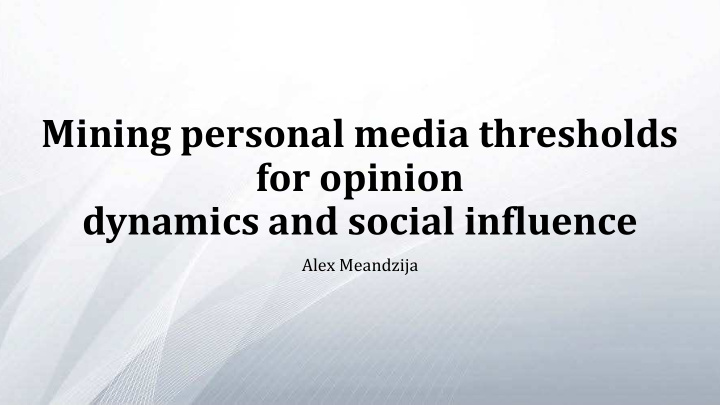



Mining personal media thresholds for opinion dynamics and social influence Alex Meandzija
Defining the Problem Transaction ID Items Dataset: 1 ABC I is a set of discrete items ( i ) 2 DE T is a set of transactions ( t ) such that t ⊆ I 3 AB 4 CDE Question: What sets of items are frequently found together in the transactions?
Example Applications • Market Basket Analysis Determining frequently co-purchased products can inform store layout • Survey Data Discrete data from surveys can be mined for trends and profiles • Website Logs Pages frequently visited in the same session by users can be hyperlinked to each other
Support Measure Support is the frequency at which an item or item set X is found in the transactions T and is defined as: Sup( X , T ) = |{ t ∊ T ; X ⊆ t }| | T | Example: Transaction ID Items Supp(A) = .5 1 ABC Supp(C) = .5 2 DE 3 AB Supp(AC) = .25 4 BCD
Apriori Algorithm Theorem: Supp(AB) ≤ Supp(A) & Supp(AB) ≤ Supp(B) Proof: any set Y such that Y ⊆ AB must satisfy Y ⊆ A and A ⊈ AB Therefore, if Supp( X ) ≤ Supp_min we can eliminate all item sets Y such that Y ⊆ X. The Apriori Algorithm uses this approach to build the frequent itemsets.
Apriori Algorithm (continued) Figure and Plot from Datamining and Analysis P. 247-248 (Zaki & Meira 2014 )
ECLAT Optimization Horizontal Database formatting allows for faster computation of support values. t( XY ) = t( X ) ⋂ t( Y ) & Supp( X ) = |t( X )| New prefixes can be generated by intersecting their bases, and their support is simply its cardinality. Transaction ID Items Items A B C D E 1 ABC TIDs 1 1 1 2 2 2 DE 3 3 4 4 3 AB 4 4 BCD
ECLAT Optimization (continued) Figure and Plot from Datamining and Analysis P. 251-252 (Zaki & Meira 2014 )
Association Rules Often, it is more important to find directional associations rather than simple frequent item sets. We call these associations rules. Examples: Eggs, Butter, and Sugar → Flour In order to draw association rules from the frequent item sets one must use interestingness measures.
Interestingness Measures Confidence : Conf( X → Y ) = Supp( XY ) Supp( X ) Lift: Supp( XY ) Lift( X → Y ) = Supp( X ) ∗ Supp( Y ) Jaccard: Supp( XY ) Jacc( X → Y ) = Supp( X ) + Supp( Y ) − Supp( XY )
Media Threshold Survey Participants asked to self-identify the number of social media items they would need to see before forming or shifting opinions given: Media types: Controversy levels: Media sources: Images: for still photos and Low: minimal (some people 1. Unknown: individual has no 1. 1. drawings would form an opinion) knowledge of the source Videos: for any animations or Medium: generally 2. Like-minded: the source of the 2. 2. moving picture controversial (most would media generally thinks similarly Messages: for text, tweets, form an opinion) to the recipient 3. and Facebook posts High: very controversial 3. Different-minded: the source 3. (most or all would form an of the media generally thinks opinion) differently from the recipient None: no reference to 4. controversy
Binning Survey Data In order to mine a dataset, it must be split up into a discrete set of items. Contiguous or open-ended response should be binned such that: 1. The bin resolution is broad enough to keep frequencies above the minimal support. 2. The bin resolution is fine enough that information is not lost in the binning process.
Responses binned by %-deviation from Avg. Individual responses log2 binned
Filtering Through the Rules One of the major challenges of data mining is the massive quantity of rules it can generate. Interestingness measures, problem considerations, and bloat reduction measures can greatly reduce the overall quantity of rules. Examples: Interestingness measure: Requiring a sizeable Minimum lift or Confidence. • Problem Considerations: If one is looking to find the variables that effect average response, requiring • average response on the RHS. Bloat Reduction: Accepting only maximal frequent item sets (Eliminating any FISs which have supersets • with equivalent support.) Filter(min) FC rule count FC %-remain FS rule count FS %-remain Support(.12/.15) 873,998 100.00 2,584,330 100.00 Confidence(.6) 360,644 41.26 1,096,151 42.42 Lift(3) 3,801 0.43 68,878 2.67 Maximal 784 0.09 25,329 0.98
Filtering – Community Detection? The prior filtering techniques can help to pull out uninteresting or unimportant rules for our data, but they little in the way of parsing the data we have found. Community detection provides a way to further filter our results by placing them into communities which can be used the base unit for analysis. Additionally, community detection can find rule clusters with substitutable items (butter and margarine) and help to pull out unneeded complexity.
Rules and Items as Bipartite Graph Fixed-Source rules as Network Fixed-Context rules as Network
SpeakEasy Community Detection Influences on choice of algorithm: Label Propagation used based community detection resilient to graph topology. • History based approach reduces the impact of random initial conditions and prevents cascades. • Multiple runs reconciled with ARI to find most representative partition. • Does not require user to set the number of partitions. • Written here at RPI! •
SpeakEasy Community Algorithm
Preliminary Results – Modular Rules The first major category of communities were sets of rules where only a couple items differed from any given rule.
Preliminary Results – Equivalent Items The second set of Communities of note were communities where mutually exclusive items co-occurred.
Recommend
More recommend